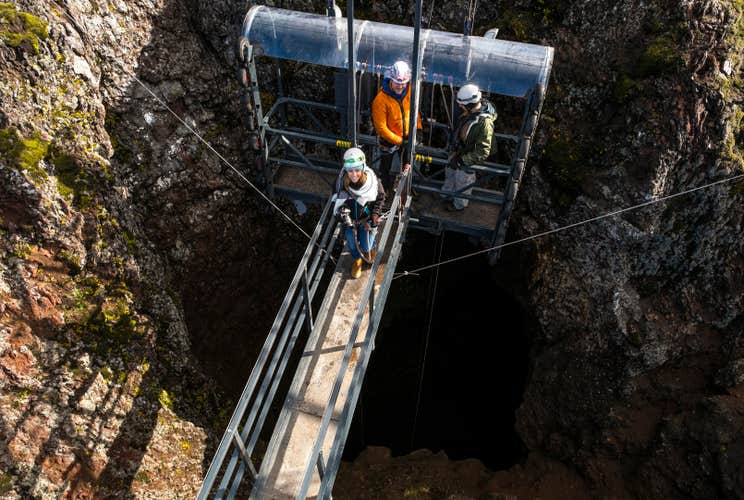Description
Résumé
Description
Descendez dans la vaste chambre magmatique d’un volcan endormi. Un voyage dans les profondeurs du volcan Thrihnukagigur est une expérience unique dans une vie. L'Islande est le seul pays au monde où une telle excursion existe ; ne manquez pas votre chance de participer à cette fabuleuse aventure.
L’aventure commencera lorsqu'on viendra vous récupérer à Reykjavik pour vous emmener aux “Montagnes Bleues” ou "Blafjoll" n islandais, situées juste à l’extérieur de la zone de la capitale.
Une fois arrivé à la base, vous recevrez une brève explication de l'aventure qui vous attend. Vous apprendrez aussi quelques faits intéressants sur ce volcan unique et vous aurez l'occasion de poser toutes les questions que vous souhaiterez à votre guide.
De là, vous vous dirigerez vers les champs de lave et marcherez jusqu'à l'entrée du volcan sur environ 3,2 km. Une fois arrivé au volcan Thrihnukagigur, la magie opèrera : vous descendrez dans son vaste intérieur grâce à un ascenseur impressionnant et unique en son genre.
Nulle par ailleurs dans le monde, il n'est possible d’entrer dans une chambre magmatique de cette façon, ce qui rend cette visite unique et précieuse. Ce voyage vers le centre de la Terre couvre 198 mètres et dure environ six minutes.
Au cours de cette lente descente, la beauté de la chambre magmatique vous émerveillera instantanément. La chaleur et la pression de la dernière éruption du Thrihnukagigur, il y a plus de 400 ans, ont créé une roche aux couleurs et à la texture incroyables.
Attendez-vous à voir des murs lisses et d’étranges formations de couleur jaune, bleue, rouge, violette et orange, si vives qu’il sera difficile de croire qu’elles ne semblent pas naturelles.
Ce ne sera pas juste la beauté du lieu qui vous laissera bouche bée, mais également sa taille. Pour vous donner un ordre idée concernant la taille de la chambre magmatique du volcan, sachez qu’on pourrait y facilement y faire rentrer la statue de la Liberté et l’emblématique église de Reykjavik, Hallgrimskirkja. Le sol de la chambre est même suffisamment grand pour construire trois terrains de basket dans cet endroit aux airs de science-fiction.
Une fois la descente dans la chambre magmatique terminée, votre guide vous laissera sortir de la nacelle et vous pourrez explorer le volcan pendant une demi-heure. N’oubliez pas d’avoir votre appareil photo à la main, car tout sans exception, des lames de lumière tombant d'en haut aux détails les plus infimes de la lave pétrifiée, est digne d'une photographie.
En explorant ce lieu unique, rappelez-vous que ce n'est que par un processus géologique étrange et inattendu que cette visite est rendue possible. Normalement, lorsqu’un volcan s’endort, sa chambre magmatique se refroidit et se solidifie. Pour des raisons inconnues, celle de Thrihnukagigur s’est drainée, laissant derrière elle un espace magnifique et inimaginable.
Après votre exploration, vous reprenez l’ascenseur pour une ascension en douceur, vers un monde lumineux et ouvert. Une fois la surface atteinte, vous vous restaurerez avec une bonne soupe de viande islandaise traditionnelle, ainsi que des boissons chaudes et des gourmandises, que vous pourrez apprécier avant de parcourir les 3,2 km qui vous ramèneront à la base. Puis, vous partirez pour la randonnée de retour vers le van. Terminez l'excursion à Reykjavik par un assez court transfert relaxant vers la ville.
Cette expérience est vraiment une opportunité unique dans une vie : descendre à l’intérieur de la chambre magmatique sublime d’un volcan endormi. Ne laissez pas passer cette chance.
Vérifiez les disponibilités dès maintenant en choisissant une date.













